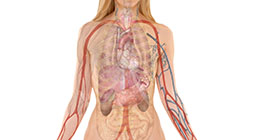
Overview
Type of Arthritis
Symptoms
Causes
Prescription
Health Tips
Arthritis (from Greek “arth” meaning joint, and “itis” for inflammation) is a condition with over 100 different forms. Gout, rheumatoid arthritis (RA), osteoarthritis, fibromyalgia and psoriatic arthritis are among some of the most common types. Although most of these disorders occur as joint or muscle inflammation, many disorders like lupus involve the skin, lungs and kidneys. Inflammation, swelling and, most importantly, pain are hallmarks of arthritis.
Over 4 million Canadians and 54 million Americans suffer from one form of arthritis or another. While prevalence does increase with age, it is not a disease affecting only the elderly. Some forms of arthritis strike toddlers while thousands are stricken in the prime of their lives.
In children and young adults gender does not seem to be complicit in its occurrence, yet arthritis is more common in adult women than men. Arthritis is the most prevalent chronic condition affecting women, particularly between the ages of 20 and 40. The National Institute of Arthritis and Musculoskeletal and Skin Diseases reports that one in seven people have some form of arthritis.
Common Types of Arthritis
- Ankylosing Spondylitis
- Gout
- Infective Arthritis
- Juvenile Chronic Arthritis
- Osteoarthritis (the most common type)
- Polymyalgia Rheumatica
- Pseudogout
- Psoriatic Arthritis
- Raynaud’s Phenomenon
- Reiter’s Disease
- Rheumatoid Arthritis
- Sjogren’s Syndrome
- Systemic Lupus Erythematosus
Symptoms
Osteoarthritis
The most common form of arthritis, osteoarthritis is a gradual wearing away of the cartilage that cushions the joints and prevents the bones from scraping against each other. New research is also finding that osteoarthritis occurs when the ability to regenerate normal cartilage is impaired. Repetitive activities and sports injuries are associated with the development of arthritis. Usually osteoarthritis appears after the age of forty. While symptoms may vary depending on the body part affected, some of the more common symptoms include:
- Bone spurs developing in the joint spaces
- Joint pain
- Joints cracking and clicking during movement
- Loss of cartilage
- Loss of mobility, stiffness that worsens over time
- Morning stiffness (an early symptom of arthritis)
- Swollen joints
Rheumatoid Arthritis (RA)
The second most common form of arthritis, RA is an autoimmune disease whereby the immune system produces antibodies that destroy the synovial membranes around the lubricating fluid in the joints. RA may begin in fits and starts, taking months or years to progress, but for about 25 percent of sufferers it begins abruptly and severely. In the case of RA, correcting the immune system abnormality is the focus of treatment.
When diagnosing RA, four out of seven criteria must be met:
- Morning stiffness that lasts more than an hour
- The arthritis is symmetrical, meaning it is on both sides of the body
- Three joint areas simultaneously inflamed (not just bony overgrowth)
- Arthritis is present in any of the hand joints
- Nodules lie under the skin on bony prominences
- Serum rheumatoid factor levels are abnormal
- Erosions or decalcifications are detected by X-ray
The joint pain and stiffness of RA is more noticeable in the morning and, like osteoarthritis, the joints become swollen. Unlike osteoarthritis, however, RA can strike suddenly in some cases and at any time of life, even in childhood (Juvenile Rheumatoid Arthritis).
Other symptoms include:
- Anemia
- Deformed hands and feet
- Depression
- Fatigue
- Fever
- Inflamed joints that take on a purplish colour
- Night sweats
- Symmetrical attacks afflicting both wrists, both ankles or both knees
- Weight loss
Causes
Osteoarthritis(OA)
Better known as “wear and tear” arthritis, as the nickname suggests it can arise from repetitive use or abuse of the joints from heavy labour, sports and injuries. A genetic predisposition may increase chances of developing OA in some people. Obesity aggravates arthritis because greater strain is put on the joints. Abnormal biomechanics of the joints increase risk. Poor nutrition, dehydration, and certain food and environmental allergies can contribute to the condition. Hormones may play a role due to declining estrogen and progesterone after menopause; a low function thyroid may also be a contributing factor. Aging is usually cited as a factor (70 percent of elderly persons have OA), so there is an assumption that it is an inevitable aspect of aging. This is not true. If care is taken to address other factors, then one may live a long life without osteoarthritis.
Rheumatoid Arthritis
Stress and its ability to affect hormones that promote inflammation can contribute to RA. Other potential causes are:
- Allergies
- Genetics
- Hyperactive immune system
- Nutritional deficiencies
- Obesity
- Viral or bacterial infections
Prescription for Health
Diet
Avoid foods that increase inflammation as they may aggravate arthritis. Reduce or cut out entirely fried foods, sugar, hydrogenated fats, refined carbohydrates, artificial sweeteners, flavours/colours, too much red meat, and poor quality or rancid fats from oils such as soy, peanuts, safflower, canola, or corn. Other foods that may cause flareups are salt, paprika and cayenne pepper, tobacco, and any member of the nightshade family (potatoes, eggplant, tomatoes, peppers, etc.).
Include foods that reduce inflammation, such as omega 3-fatty acids, fresh and cold-pressed organic flax seed oil, extra-virgin olive oil, vegetables, fruits, bone broth, fatty fishes (sardines, mackerel, salmon), legumes, whole grains such as millet, amaranth, buckwheat, and quinoa. Eating foods with high sulfur content (garlic, onions and asparagus) will help remove metals from the body.
| Nutrient | Dosage | Action |
|---|---|---|
| Moducare®
(Beta-Sitosterol, Beta-Sitosterolin-Beta-D-Glucoside) |
20 mg / 0.2 mg
Adults and children 17 years and older take 1 capsules three times daily OR 2 capsules upon rising and 1 capsule before bed. Children 5 to 10 years take 1 capsule or chewable tablet, one to two times daily. |
Helps to support a healthy immune system balance; helps to alleviate stiffness and pain, and reduce inflammation |
| Natural Eggshell Membrane (NEM) | One capsule daily with food | Relieves pain and stiffness in 7 days; helps rebuild cartilage |
| Vitamin D3 | Take D3 up to 10 000 IU per day until your vitamin in blood test has you in the 30 to 60 ng/MLFor maintenance:
Summer dose: 2000 – 5000 IU/daily Winter dose: 5000 – 10 000 IU/daily |
Controls arthritis disease activity and reduces symptoms |
| Celadrin | 1–2 softgels 3 times daily with meals 1050 mg | Anti-inflammatory, reduces pain and swelling of joints |
| Omega-3 Essential Fatty Acids | 800 mg of DHA and 200 mg of EPA | Potent anti-inflammatory; improves mobility |
| Glucosamine Sulfate | 500 mg three times daily | For cartilage repair
Caution: Glucosamine may disrupt blood sugar in diabetics |
| MSM | 1–2 grams daily | Anti-inflammatory |
| Borage Oil
GLA Skin Oil |
2000 mg daily | Relieves pain and inflammation |
| SAM-e
(S-adenosyl-methionine) |
200 mg twice daily | Contains enzymes, anti-inflammatory, improves joint mobility, reduces swelling |
| Bromelain | 2000–6000 mcu (1300–4000 gdu) on an empty stomach | Contains enzymes, anti-inflammatory, improves joint mobility, reduces swelling |
| Boswellia | Standardized dose of 400 mg, three times daily | Anti-inflammatory; as effective as NSAIDs |
| DHEA | Ask your doctor for a DHEA test to see if you are deficient
5-10 mg daily (In Canada DHEA is available by prescription) |
Reduces IL-6, normalizes cortisol and stops inflammatory processes |
Tips to Enhance Healing
- Avoid foods that may cause flareups: processed foods, sugars, meats
- Beware of taking non-steroidal anti-inflammatory drugs (NSAIDs), such as celecoxib and acetaminophen long term due to gut problems.
- Consume natural, whole foods: fresh fruit, vegetables, legumes, whole grains, healthy fats and oils, seafood and fresh fish.
- Drink plenty of pure, clean water every day to prevent joint cushions from becoming dehydrated. For every alcoholic beverage consumed, drink another glass of water.
- Lose weight. Even 10 extra pounds may cause an additional 40 pounds of pressure on arthritic knee and ankle joints.
- Practice non-weight-bearing exercise like water aerobics, swimming, stationary cycling, and yoga. Be careful not to overburden joints or cause pain and inflammation.
- Start a diet diary and write down everything eaten to see if there is any correlation to arthritis symptoms. Ask for a referral to an allergy specialist and get tested for possible allergen triggers. Some allergies may only be detected with the help of an ELISA test. Avoid those specific allergens once determined.
- Use hot or cold compresses on the area to alleviate pain and inflammation. Take hot baths or saunas to keep the joints warm.
- Use topical medicinal ointments. Look for products that contain menthol, peppermint and eucalyptus.










